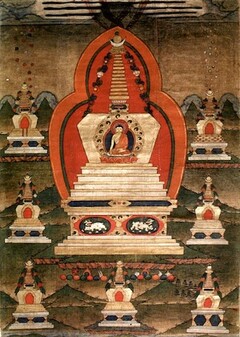The Proportions of Stūpas
On the Proportions of Stūpas and Suchlike
by Jamyang Khyentse Chökyi Lodrö
Amṛta vijayantu!
Regarding the origin of proportions, The Treasury of All-Encompassing Knowledge says:
On the uncommon level, as taught in the Kālacakra,
The stūpa of primordial wisdom corresponds to:
The cross-legged buddha’s lower body in its steps,
His abdomen in its dome plinth,
His upper torso in its bulging dome,
His throat in its high pavilion, his head up to the ūrṇā
In its canopy face, and the top of his head in its stacked dharma wheels and crest.
Outer, inner and other thus accord within a single expression.
This explains the origin of the measurements. The antithesis of this, something made haphazardly without such proportions, will always be objectionable. As the guide to proportions by Tulku Sangye Lhawang[1] says:
Otherwise, what is fashioned according to your own preference
Will not inspire faith but waste resources.
If established, it will not inspire devotion but accumulate defilement.
If gifted, it will be unwanted by others and will be a cause of shame.
If venerated, it will not inspire pure vision but disturbed dreams.
Having therefore cast aside such innovative, unconventional styles,
The intelligent should take note of proper proportions.
Regarding beautiful, attractive supports for offering[2]with proper measurements, the above-cited text says:
Well-constructed, proportionate and attractive, it is a field of offering,
A support for gathering the two accumulations of merit and wisdom.
As this indicates, it is vitally important to pay attention to avoiding what is flawed and pursuing what is positive.
Let us conclude with verse:
Support for accomplishment, surety for attainment,
Healer of impairments, breakages, veils and thought,
With billows of offerings to delight the maṇḍala
And baliṃta of fourfold understanding,
Magical focus for transforming into all that is desirable,
Gateway to the auspicious provision of food and the like,
With the key point from oral instructions of five types of ringsel,
With the special quality of profound secret mantra,
All the oral instructions of the omniscient guru,
And with the splendid motivation of a wish to benefit all
May the two glorious accumulations be spontaneously achieved!
| Translated by Adam Pearcey 2021, with the generous support of the Khyentse Foundation and Terton Sogyal Trust.
Bibliography
Tibetan Edition
'jam dbyangs chos kyi blo gros. “mchod rten sogs kyi cha tshad bshad pa/“ in 'jam dbyangs chos kyi blo gros kyi gsung ’bum. 12 vols. Bir: Khyentse Labrang, 2012. W1KG12986. Vol. 11: 605–606
Secondary Sources
Jackson, David, P. A History of Tibetan Painting: The Great Tibetan Painters and Their Traditions. Wien: Verlag der Österreichischen Akademie der Wissenschaften, 1996
Jamgön Kongtrul Lodrö Thayé, The Treasury of Knowledge, Book Six Parts One and Two: Indo-Tibetan Classical Learning and Buddhist Phenomenology, transl. Gyurme Dorje. Boston and London, 2012.
Version: 1.0-20210630
